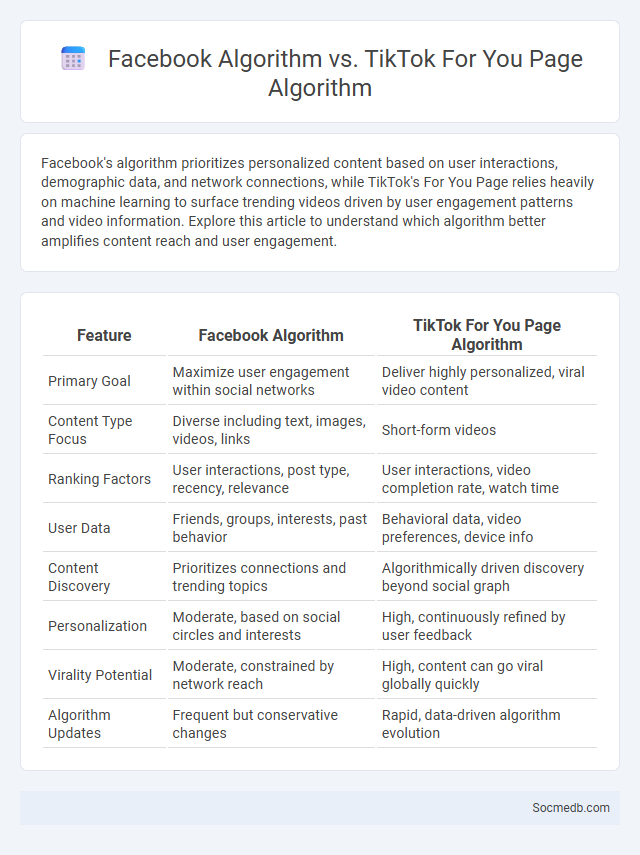
Photo illustration: Facebook Algorithm vs TikTok For You Page Algorithm
Facebook's algorithm prioritizes personalized content based on user interactions, demographic data, and network connections, while TikTok's For You Page relies heavily on machine learning to surface trending videos driven by user engagement patterns and video information. Explore this article to understand which algorithm better amplifies content reach and user engagement.
Table of Comparison
| Feature | Facebook Algorithm | TikTok For You Page Algorithm |
|---|---|---|
| Primary Goal | Maximize user engagement within social networks | Deliver highly personalized, viral video content |
| Content Type Focus | Diverse including text, images, videos, links | Short-form videos |
| Ranking Factors | User interactions, post type, recency, relevance | User interactions, video completion rate, watch time |
| User Data | Friends, groups, interests, past behavior | Behavioral data, video preferences, device info |
| Content Discovery | Prioritizes connections and trending topics | Algorithmically driven discovery beyond social graph |
| Personalization | Moderate, based on social circles and interests | High, continuously refined by user feedback |
| Virality Potential | Moderate, constrained by network reach | High, content can go viral globally quickly |
| Algorithm Updates | Frequent but conservative changes | Rapid, data-driven algorithm evolution |
Understanding Social Media Algorithms
Social media algorithms analyze user behavior, preferences, and engagement patterns to curate personalized content feeds that maximize user interaction. These algorithms prioritize posts based on factors like relevance, timeliness, and user relationships, influencing visibility and reach. Understanding platform-specific algorithms, such as Facebook's EdgeRank or Instagram's Explore page mechanics, is essential for optimizing content strategy and enhancing audience engagement.
Overview of the Facebook Algorithm
Facebook's algorithm prioritizes content that fosters meaningful interactions, analyzing factors such as user engagement, post type, and timeliness to tailor your News Feed. It ranks posts from friends, family, and pages based on relevance, predicting what content you are most likely to engage with. Understanding this dynamic system can help you optimize your posts for greater visibility and interaction.
How the TikTok For You Page Algorithm Works
The TikTok For You Page algorithm curates content by analyzing user interactions such as video likes, shares, comments, and watch time to personalize the feed. It leverages machine learning models to predict user preferences, prioritizing videos with high engagement rates and a diverse range of creators to maintain content freshness. Factors like device type, location, and video information, including captions and hashtags, also influence the recommendation system to enhance user experience.
Key Differences Between Facebook and TikTok Algorithms
Facebook's algorithm prioritizes content based on user interactions, such as likes, comments, and shares, emphasizing meaningful social connections and community engagement. In contrast, TikTok's algorithm leverages a powerful recommendation system driven by AI analysis of user behavior, video information, and device data to deliver highly personalized content on the For You page. While Facebook focuses on friend networks and interests, TikTok excels in quickly surfacing trending and viral content tailored to individual preferences.
Content Discovery: Facebook vs TikTok
Facebook's content discovery relies heavily on algorithm-driven newsfeeds prioritizing friends, groups, and pages you follow, offering personalized but familiar content. TikTok uses a highly sophisticated AI recommendation system centered on user interactions such as watch time and engagement, delivering a constant stream of fresh, viral, and diverse videos that quickly adapt to your preferences. Your experience on TikTok tends to be more exploratory, while Facebook emphasizes connections within your existing network.
User Engagement and Virality Factors
User engagement on social media is driven by interactive content, timely responses, and personalized experiences that encourage likes, comments, and shares. Virality factors include emotional resonance, relatability, and the use of trending hashtags or challenges that boost shareability across networks. To maximize your social media impact, create authentic content that sparks conversations and leverages platform-specific algorithms for wider reach.
Personalization and Recommendation Techniques
Personalization and recommendation techniques in social media leverage machine learning algorithms and user behavior analytics to deliver tailored content, enhancing engagement and user experience. Collaborative filtering, content-based filtering, and hybrid models analyze user interactions, preferences, and demographic data to predict and suggest relevant posts, advertisements, and connections. These advanced methods increase retention rates by providing customized feeds that align with individual interests and social networks.
Impact on Creators and Businesses
Social media platforms have transformed how creators and businesses engage with audiences, enabling direct interaction and personalized content delivery. Your brand visibility and revenue opportunities expand significantly by leveraging targeted advertising and influencer partnerships. Consistent content creation and data-driven strategies are essential for maximizing growth and maintaining competitive advantage in this digital landscape.
Privacy and Data Usage Concerns
Social media platforms collect extensive user data, raising significant privacy and data usage concerns. Users often face risks from unauthorized data sharing, targeted advertising, and potential breaches compromising sensitive information. Strengthening data protection policies and transparent privacy settings remain critical for safeguarding personal information in digital interactions.
Future Trends in Social Media Algorithms
Future trends in social media algorithms will emphasize personalized content through advanced AI and machine learning technologies, enhancing user engagement by predicting preferences with greater accuracy. Platforms will increasingly integrate real-time data analysis to curate dynamic feeds and optimize advertisement targeting, maximizing relevance and user interaction. Understanding these evolving algorithms can help you leverage social media more effectively for marketing and communication strategies.
 socmedb.com
socmedb.com